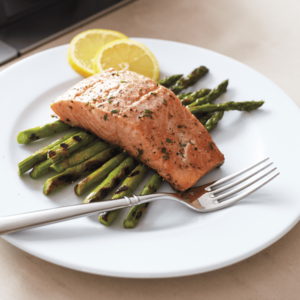How to make Savoury Zone Friendly Grilled Salmon with Asparagus
Grilled Salmon with Asparagus is a juicy and savoury seafood dish, which is suitable for the Zone Diet (a nutrition plan that emphasizes a balance of protein, carbohydrates, and fat to promote weight loss and overall health). This dish is high in protein and healthy fats, with salmon being a great source of omega-3 fatty acids. Asparagus provides dietary fiber and essential vitamins and minerals. The marinade adds flavor without adding excess calories or sugar.
Here’s a recipe for a delicious and nutritious Grilled Salmon with Asparagus Dish that is suitable for the Zone Diet:

Grilled Salmon with Asparagus (Zone Diet)
Equipment
- 1 Griller
- Few Charcoal
Ingredients
- 4 salmon fillets
- 1 pound asparagus trimmed
- 2 tablespoons olive oil
- 2 tablespoons lemon juice
- 1 tablespoon honey
- 1 tablespoon Dijon mustard
- Salt and pepper to taste
Instructions
- Preheat grill to medium-high heat.
- In a small bowl, whisk together the olive oil, lemon juice, honey, Dijon mustard, salt, and pepper to make the marinade.
- Place the salmon fillets in a shallow dish and pour the marinade over them. Turn the salmon to coat well and marinate for 10-15 minutes.
- Meanwhile, toss the asparagus with a drizzle of olive oil and season with salt and pepper.
- Grill the salmon fillets for about 4-5 minutes per side, or until cooked to your liking.
- Grill the asparagus for about 5-6 minutes, turning occasionally, until tender and lightly charred.
- Serve the grilled salmon with the asparagus on the side.
Notes
Nutrition Info: This recipe makes 4 servings. Each serving contains approximately:
- Calories: 292
- Protein: 28g
- Carbohydrates: 9g
- Fat: 17g
- Fiber: 3g
Grilled Salmon with Asparagus recipe is a great option for those following the Zone Diet, as it contains a good balance of protein, carbohydrates, and fat. The salmon is a rich source of omega-3 fatty acids, while the asparagus provides fiber and essential vitamins and minerals. The marinade adds flavor without adding excess calories or sugar.
ZONE BLOCKS
Here are the approximate Zone blocks in the entire dish:
- 4 salmon fillets: 16 blocks of protein and 8 blocks of fat
- 1 pound asparagus trimmed: 2 blocks of carbohydrate and less than 1/2 block of protein
- 2 tablespoons olive oil: 3 blocks of fat
- 2 tablespoons lemon juice: negligible protein, fat, and carbohydrates
- 1 tablespoon honey: 3 blocks of carbohydrate
- 1 tablespoon Dijon mustard: negligible protein, fat, and carbohydrates
- Salt and pepper: negligible protein, fat, and carbohydrates
Zone Blocks per serving:
- Protein: 4 blocks (all from salmon)
- Carbohydrate: 1.25 blocks (2 from asparagus and 3 from honey in total)
- Fat: 2.5 blocks (8 from salmon and 3 from olive oil)
Note: The Zone diet recommends balancing every meal and snack with a specific ratio of macronutrients, typically consisting of 30% protein, 40% carbohydrate, and 30% fat. These block calculations are based on the Zone diet’s recommended macronutrient ratios and serving sizes. However, it is always best to consult a registered dietitian or healthcare provider to determine the specific nutrition needs for individual goals and health conditions.







